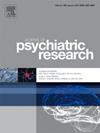老年人体弱与自杀倾向之间的关系:一项横断面研究。
IF 3.7
2区 医学
Q1 PSYCHIATRY
引用次数: 0
摘要
研究目的本研究旨在调查美国老年人不同程度的虚弱与自杀意念(SI)之间的潜在相关性:我们的横断面研究从 2005-2018 年的 NHANES 中提取了年龄≥60 岁的成年人的数据。评估虚弱程度的方法是计算虚弱指数,将个体分为健壮型、前虚弱型和虚弱型。SI利用PHQ-9的第9项进行评估。分析采用了逻辑回归和限制性三次样条:分析包括 8564 名参与者,结果显示有 3.3% 的人报告患有 SI。在粗略模型中,老年人体弱与 SI 之间的关系具有显著的统计学意义(OR:5.94,95% CI:3.46-11.27,总 P <0.001,P 非线性 = 0.771):结论:体弱似乎会使老年人更容易产生自杀意念。培训医护人员识别和解决与虚弱相关的心理健康问题至关重要。通过综合干预措施,我们可以更好地保护老年人的精神健康,降低自杀风险。本文章由计算机程序翻译,如有差异,请以英文原文为准。
Association between frailty and suicidal ideation in older adults: A cross-sectional study
Objectives
This study seeks to investigate the potential correlation between various levels of frailty and suicidal ideation (SI) in older adults from the USA.
Methods
Our cross-sectional study extracted data on adults ≥60 years from the NHANES in 2005–2018. Frailty levels were assessed by computing the Frailty Index, classifying individuals into robust, prefrail, and frail categories. SI was evaluated utilizing Item #9 of PHQ-9. Logistic regression and restricted cubic splines were employed for analysis.
Results
The analysis comprised 8564 participants, revealing that 3.3% reported experiencing SI. The association between frailty and SI in older adults was statistically significant in crude model (OR: 5.94, 95% CI: 3.46–11.27, P < 0.001). Upon adjusting for baseline characteristics, the association remained robust (AOR: 5.35, 95% CI: 3.09–10.19, P < 0.001). Model II did not substantially alter the association between frailty and SI after further adjustment for lifestyle factors (AOR: 5.23, 95% CI: 3.02–9.98, P < 0.001). In a sensitivity analysis controlling for depression, the association remained statistically significant (AOR:3.62, 95%CI: 1.76–8.75, P = 0.001). Furthermore, the associations between the Frailty Index and SI were pronounced in the restricted cubic spline (RCS) models (P overall < 0.001, P nonlinearity = 0.771).
Conclusion
Frailty appears to heighten vulnerability to suicidal ideation in older adults. Training healthcare professionals to identify and address mental health issues related to frailty is crucial. Through comprehensive intervention measures, we can better safeguard the mental well-being of older adults and reduce the risk of suicide.
求助全文
通过发布文献求助,成功后即可免费获取论文全文。
去求助
来源期刊

Journal of psychiatric research
医学-精神病学
CiteScore
7.30
自引率
2.10%
发文量
622
审稿时长
130 days
期刊介绍:
Founded in 1961 to report on the latest work in psychiatry and cognate disciplines, the Journal of Psychiatric Research is dedicated to innovative and timely studies of four important areas of research:
(1) clinical studies of all disciplines relating to psychiatric illness, as well as normal human behaviour, including biochemical, physiological, genetic, environmental, social, psychological and epidemiological factors;
(2) basic studies pertaining to psychiatry in such fields as neuropsychopharmacology, neuroendocrinology, electrophysiology, genetics, experimental psychology and epidemiology;
(3) the growing application of clinical laboratory techniques in psychiatry, including imagery and spectroscopy of the brain, molecular biology and computer sciences;
 求助内容:
求助内容: 应助结果提醒方式:
应助结果提醒方式:


